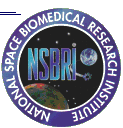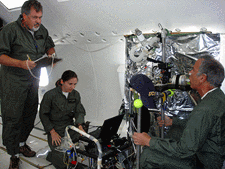NSBRI Report Says Lunar Astronauts May Be Affected By Dust
 Lunar dust could be more than a
housekeeping issue for astronauts who visit the moon. Their good
health may depend on the amount of exposure they have to the tiny
particles, according to a recent release from the National
Space Biomedical Research Institute.
Lunar dust could be more than a
housekeeping issue for astronauts who visit the moon. Their good
health may depend on the amount of exposure they have to the tiny
particles, according to a recent release from the National
Space Biomedical Research Institute.
To prepare for a return to the moon, researchers with the NSBRI
are evaluating how dust deposits in the lungs in reduced gravity in
order to assess the health risk of long-term exposure to the
particles. The findings will influence the design of lunar bases
and could also provide benefits for health care on Earth, such as
improved delivery of aerosol medications to the lungs.
NSBRI Human Factors and Performance Team researcher Dr. Kim
Prisk said there are major questions that need to be answered. "In
the big picture, the questions are: How much goes into the lung?
Where does it go? How long does it stay? And how nasty is the
stuff?" said Prisk, who is an adjunct professor in the Department
of Medicine at the University of California, San Diego.
During the Apollo lunar missions in the late 1960s and 1970s,
the clingy particles were easily transported via spacesuits into
the lunar lander following moonwalks. The amount of dust inside the
vehicle was so great some astronauts reported they could smell
it.
Even though there were no known illnesses due to exposure, lunar
dust is a concern because it has properties comparable to that of
fresh-fractured quartz, a highly toxic substance. However, the
Apollo flights lasted only a few days. During the proposed return
to the moon, astronauts will be exposed to lunar dust for longer
periods of time, including missions that could last months.
Due to the moon’s reduced gravity and the size of its dust
particles, the respiratory system’s process to remove
unwanted matter may not work as efficiently as it does on Earth.
"In the moon’s fractional gravity, particles remain suspended
in the airways rather than settling out, increasing the chances of
distribution deep in the lung, with the possible consequence that
the particles will remain there for a long period of time," Prisk
said.
The lungs are a highly sensitive organ because of the large
surface area that delivers oxygen molecules through a thin membrane
directly to the blood. The health risk to astronauts increases as
dust particles go deeper into the lungs.
 To conduct the research, scientists
take measurements during flights on NASA’s Microgravity
Research Aircraft. These airplanes are used to provide short
periods of reduced- and zero-gravity during a series of steep
climbs and descents.
To conduct the research, scientists
take measurements during flights on NASA’s Microgravity
Research Aircraft. These airplanes are used to provide short
periods of reduced- and zero-gravity during a series of steep
climbs and descents.
"During the portions of the flight in which gravity is reduced
to levels seen on the lunar surface, we inject particles into a
mouthpiece through which the study participants breathe," Prisk
said. "Subjects breathe in and out, and we measure how the
particles behave and how many end up inside the lung."
Prisk said the research flights have been beneficial so far.
"With the reduced-gravity flights, we’re improving the
process of assessing environmental exposure to inhaled particles,"
he said. "We’ve learned that tiny particles (less than 2.5
microns) which are the most significant in terms of damage, are
greatly affected by alterations in gravity."
The next step is to investigate the risks and determine ways to
limit exposure. The severity of the risks will determine the level
of engineering work needed to limit exposure to lunar dust, which
also can cause problems for equipment.
As for benefits on Earth, the research could give scientists a
better understanding of how the lungs work, improving the
understanding of how particles distribute within the lungs.
"If we learn how to target drugs to specific areas inside the
lung, it will be possible to achieve optimal results with small
quantities of drugs delivered to exactly the right place in the
lung, and it will minimize side effects," Prisk said.
 ANN's Daily Aero-Linx (04.16.24)
ANN's Daily Aero-Linx (04.16.24) Aero-News: Quote of the Day (04.16.24)
Aero-News: Quote of the Day (04.16.24) Airborne 04.10.24: SnF24!, A50 Heritage Reveal, HeliCycle!, Montaer MC-01
Airborne 04.10.24: SnF24!, A50 Heritage Reveal, HeliCycle!, Montaer MC-01 Airborne 04.12.24: SnF24!, G100UL Is Here, Holy Micro, Plane Tags
Airborne 04.12.24: SnF24!, G100UL Is Here, Holy Micro, Plane Tags Airborne-Flight Training 04.17.24: Feds Need Controllers, Spirit Delay, Redbird
Airborne-Flight Training 04.17.24: Feds Need Controllers, Spirit Delay, Redbird




